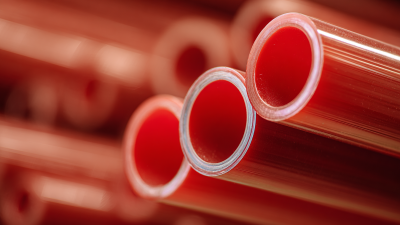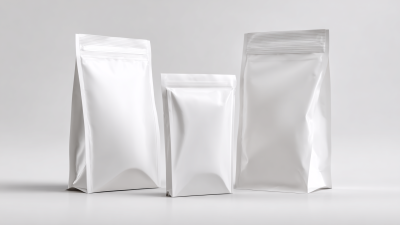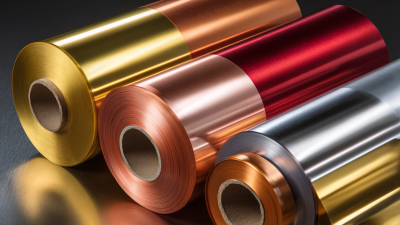Leave Your Message
In the ever-evolving landscape of packaging solutions, the Coex Tube has emerged as a versatile option that caters to a variety of industries, from cosmetics to pharmaceuticals. This innovative packaging format offers numerous advantages such as enhanced barrier properties, sustainability, and customization possibilities. As consumers increasingly seek products that align with their ecological values and as brands strive to differentiate themselves in a crowded marketplace, understanding the essential features of Coex Tubes becomes paramount.

This ultimate guide delves into the critical aspects that you must consider when evaluating Coex Tubes, including materials, applications, and alternative types that can complement or enhance your packaging strategy. Armed with this knowledge, businesses can make informed decisions that not only meet market demands but also elevate their product presentation and sustainability efforts.
When selecting a coex tube for optimal performance, several key features should be at the forefront of your decision-making process. First and foremost, consider the material composition of the tube. High-quality polyethylene or polypropylene materials are essential for ensuring durability and flexibility, providing a balance that allows the tube to withstand various environmental conditions while maintaining its structural integrity. Additionally, ensure the coex tube has a good barrier performance, which is crucial for applications requiring protection against gas and moisture permeation.

Another critical feature is the tube's wall thickness and diameter specifications. The right thickness not only affects the tube's strength but also influences its flow characteristics. A thicker wall may increase durability but could also lead to reduced flexibility, so finding the right balance is essential for your specific application. Furthermore, custom sizes may be necessary depending on the system's requirements, and flexibility in diameter options can enhance compatibility with existing setups. Lastly, consider the tube's thermal stability and chemical resistance, particularly if the tube will be used in harsh environments, ensuring that it can maintain performance over time without degradation.
When considering coex tubes, material selection plays a critical role in determining their performance and suitability for specific applications. Coex tubes are typically made from different polymers layered together, which allows for the combination of various properties tailored to meet diverse requirements. For instance, the outer layer may be engineered for high durability and resistance to environmental factors, while the inner layer can be optimized for flexibility or chemical compatibility. This multifaceted approach helps enhance the tube's overall functionality while minimizing costs associated with using a single type of material.
Moreover, the importance of understanding the specific characteristics of each material cannot be overstated. Factors such as temperature resistance, UV stability, and impact strength are crucial in ensuring that the coex tubes perform reliably in their intended environments. Different applications may require different combinations of these properties, making it imperative to select materials wisely. A comprehensive understanding of these elements not only aids in choosing the right coex tube but also contributes to the efficiency and longevity of the materials used in various industries, ranging from automotive to medical applications.
When considering coex tubes, understanding their essential specifications is crucial to making an informed choice. The thickness of a coex tube plays a significant role in its strength and durability. Generally, thicker tubes can withstand greater pressure and are less likely to deform under stress, which is particularly important in high-demand applications. Additionally, the length of the tube should align with the specific requirements of your intended use, ensuring both effectiveness and efficiency.
Moreover, factors such as material composition and performance characteristics often echo the considerations inherent in other industries, like bicycle frame selection, which varies widely among aluminum, steel, titanium, and carbon fiber. Just as each bike frame material has its unique benefits and drawbacks, coex tubes offer a range of material options that influence overall performance, flexibility, and weight. By meticulously evaluating these aspects—including thickness, length, and material—professionals can optimize their projects and enhance product longevity.
When considering the applications of Coex tubes, it’s imperative to delve into the specific features that make them an optimal choice for various industries. Coex tubes, known for their multi-layer structure, excel in providing enhanced barrier properties and flexibility. This makes them particularly suitable for the packaging of food, pharmaceuticals, and chemicals, where product integrity and safety are paramount. Furthermore, the tubes’ resistance to moisture and gases helps preserve the quality of sensitive materials, aligning perfectly with industries striving for innovation and high standards.
In sectors like construction and transportation, the role of Coex tubes is evolving alongside technological advancements. Recent developments, such as smart transportation solutions tested in urban areas, highlight the growing need for reliable, durable materials. Coex tubes, by virtue of their adaptability and performance, become essential in infrastructure projects that incorporate advanced technologies. As cities increasingly turn toward sustainability and modernization, selecting the right materials like Coex tubes will be crucial in meeting future challenges while fostering efficiency and growth in applications that require both strength and versatility.
 When selecting a supplier for your Coex tube needs, it's crucial to ensure they possess a solid reputation within the industry. Look for suppliers who have a proven track record of delivering high-quality products consistently. Research their reviews and ask for testimonials from previous clients to gauge their reliability and service quality. A good reputation often correlates with excellent customer support and after-sales service, which can be invaluable for your ongoing projects.
When selecting a supplier for your Coex tube needs, it's crucial to ensure they possess a solid reputation within the industry. Look for suppliers who have a proven track record of delivering high-quality products consistently. Research their reviews and ask for testimonials from previous clients to gauge their reliability and service quality. A good reputation often correlates with excellent customer support and after-sales service, which can be invaluable for your ongoing projects.
Another key factor to consider is the supplier's production capabilities. Different applications require varying specifications, so it’s essential to choose a supplier that offers versatility in their manufacturing processes. Inquire about their technology and equipment, as well as their ability to customize products to meet your specific requirements. This flexibility can significantly influence the success of your own operations.
Lastly, don’t overlook the importance of compliance and certification. Ensure that the supplier adheres to relevant industry standards and possesses the necessary certifications. This not only guarantees product quality but also assures you that the materials are safe and suitable for their intended use. Verifying these aspects can save you time, money, and potential legal issues in the long run.






